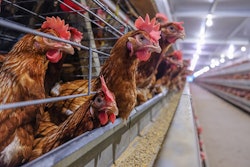
A growing number of strains of Salmonella and Campylobacter bacteria in the EU have become multi-drug resistant, concludes an annual report on antimicrobial resistance in zoonoses from the European Centre for Disease Prevention and Control (ECDC) and the European Food Safety Authority (EFSA).
Campylobacter is the cause of one of the most commonly reported gastrointestinal bacterial diseases in the EU, followed closely by Salmonella. In both cases, fresh poultry meat or eggs are considered the biggest identified sources of infection. In recent years, the poultry and turkey industries have drastically reduced the amount of antibiotic use in response to consumer demand for antibiotic-free and no antibiotics ever meat.
Both types of bacteria show resistance to ciprofloxacin, the antibiotic of choice for treating infections caused by Salmonella and Campylobacter. In certain types of Salmonella, human resistance to the antibiotic increased to 4.6% in 2018, up from 1.7% in 2016. Sixteen of the 19 countries located in the EU have reported very high or extremely high percentages of ciprofloxacin resistance to Campylobacter.
In 2018, sporadic cases of human Salmonella infections that were resistant to the last-line antimicrobial, carbapenems.
“Finding carbapenem resistance in foodborne bacteria in the EU is a concern. The most effective way to prevent the spread of carbapenem-resistant strains is to continue screening and respond promptly to positive detections. ECDC is working with EU Member States and with EFSA in a One Health approach to enhance the early detection and monitoring, in an effort to fight the persisting threat of antimicrobial-resistant zoonotic infections,” Mike Catchpole, ECDC’s chief scientist, said.
In poultry, experts also noted high proportions of resistance to ciprofloxacin in Salmonella and E. coli bacteria found in poultry, according to the report.
Good news…
The report did have some good news regarding susceptibility to antimicrobials in food-producing animals. For E. coli infections, fewer than 25% of Member States reported increased susceptibility between 2014 and 2018.
Additionally, decreasing trends in the occurrence of extended-spectrum β-lactamase (ESBL) or AmpC-producing E. coli were seen in approximately 40% Member States during 2015-2018.
“The positive findings in food-producing animals are encouraging because they are a sign of improvement. However, we need to further investigate the reasons behind this change. Antimicrobial resistance is a serious threat to global public and animal health – or One Health – that requires global action,” said Marta Hugas, EFSA’s chief scientist.
Like what you just read? Sign up now for free to receive the Poultry Future Newsletter.


















